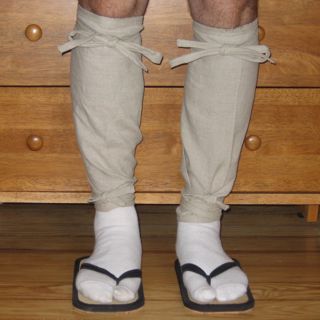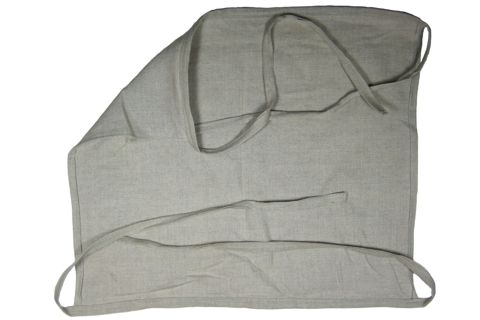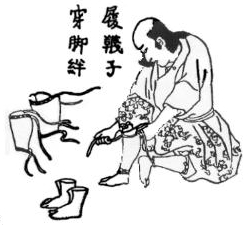Kyahan
Japanese shin coverings

July 2007

July 2007
Kyahan (or "kiahan") are gaiter type leg coverings worn by soldiers under their leg armor, or by other people (farmers, travelers, pilgrims, etcetera) whose lower legs may need some protection. They are worn over tabi (socks). If they are worn with other leggings, such as hakama or mompei, I often see the leggings tied just above the kyahan, below the knee.
I'm told some variety of kyahan are simply tubes sewn to the bottom of hakama legs, but these are flat rectangles of fabric that wrap around the leg and are tied in place.
Instead of the trapezoidal design I saw in most sets of instructions, I simply made mine out of rectangular (nearly square) pieces of fabric. These makes quite a bit of overlap at the bottom, but it keeps the whole thing "sealed up" from knee to ankle.

These are made entirely from an unbleached "natural" linen that I bought at the fabric store. I've used this fabric for a couple of other things. It's a bit heavier and stiffer than you might expect, so it's a good utility fabric, and actually provides some protection.
I started with a couple of 15 inch wide panels and worked from there. I cut two pieces, each three inches longer than the circumference of the meatiest part of my calves. I finished the raw edges at the ends with a narrow hem.
The ties are made by cutting four strips an eighth of a panel (about 2 inches) wide and three times as long as the body pieces. Each tie is folded in half lengthwise, then the raw edges are folded inside into the crease, so the ties wind up being about a half inch wide. The remaining raw edges of the kyahan body are centered on the ties, then put inside the open edge of the ties.
Lastly, sew up the entire open edge of the ties, which also attaches them firmly to the body of the kyahan.

While this design is different from a lot of kyahan I have seen pictures of, it does seem to match this picture from Tanki Yoriaku pretty well.

I tried making the "shaped" kyahan that most people favor, but I found that they did not fit as well. Curving the vertical edges to match the contours of my leg was very difficult, and did not produce a flat closure when worn. Angling the edges from max width down to ankle circumference used way more fabric, and did not yield significantly better results. These rectangular kyahan worked best for me, though your mileage may vary.